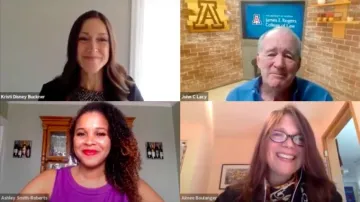
Mining companies must effectively address community needs as they develop the minerals required by the modern world. That was the bottom line at the fifth annual Mining Law Summit held online in early November by the University of Arizona Global Mining Law Program. More than 120 registrants gathered remotely for “New Frontiers in Community Engagement and Sustainable Development of Mineral Resources.” Global experts spoke of the progress and challenges facing mining companies that want to supply lithium, cobalt, graphite, zinc and other minerals as demand increases for batteries, solar panels and other green-energy products and systems.
The panel on “Responsible Mining and the Green Energy Transition” started with the premise that extraction is crucial. “There will be no climate action without mining,” said Daniele La Porta, senior mining specialist with the World Bank Group. “This message is a lot more clear now. Mining will be key to getting to this low-carbon future.” Demand for certain rare earth and other metals will increase 500% by 2050 just to meet the needs in new energy-generation and storage facilities. “That’s already significant,” La Porta said, “and overall infrastructure was not factored in.” A major concern is that metals recycling cannot currently meet the demand. The technology and business case doesn’t yet exist to close that circle of use. The next best step is to reduce the intensive carbon generation of mining operations.
This is where an organization like the U.S. Department of Energy’s National Renewable Energy Laboratory provides help. “We’re engaging with the mining sector directly,” said Travis Lowder, an NREL project manager with the Integrated Applications Center. The goal: “To assist them in achieving their carbon targets and their climate goals,” he said.
Tackling the great needs for electricity at mines is “the best opportunity to reducing carbon intensity,” Lowder said.
Meeting mineral demand doesn’t absolve companies from sustainable practices
Mining efforts to meet the demand of a green energy transition must not focus only on environmental impacts, the panel discussed. Partnerships with governments and communities near mine sites must lift economies and societies, too. “This is an opportunity for resource-rich developing countries to supply demand,” said La Porta.
To that end, the World Bank has worked with the government of Chile on setting climate-smart goals for copper mining. Indonesia is working on a similar roadmap.
The Columbia Center on Sustainable Investment also works collaboratively with mining companies and communities. “The green transition is so mining intensive,” said Perrine Toledano, who co-developed and heads the center’s focus on extractive industries and sustainable development.
The center uses as a template for its work the 17 United Nations Sustainable Development Goals (SDGs). Some of those goals focus specifically on the environment, but Toledano thinks the mining industry needs to address more than that. “Mining has the incredible responsibility to ensure the green transition doesn’t work just for some SDGs, but for all of them,” she said. She mentioned several progressive moves by mining companies, including:
- a pilot waterless mine operation
- the take-over of a closed mine’s renewable project by the Burkina Faso government
- companies tying performance bonuses to emission reduction targets.
A snapshot from the Mining Law Summit 2020 presentation on Responsible Mining and the Green Energy Transition

A snapshot from the Mining Law Summit 2020 presentation on Responsible Mining and the Green Energy Transition
While these are good examples of how sustainable development can benefit both companies and communities, the industry still has much more to do, starting with adjusting the economic mindset. “They really need to stop the disconnect between industrial policy and climate change policy,” Toledano said. Companies are accepting the idea that reducing their carbon footprint leads to efficient, cost-saving operations. “It’s been very heartening to hear from these companies that they are invested in implementing the technology that will help them transition to a lower carbon opportunity,” Lowder said. La Porta echoed that optimism. “I’m seeing policy momentum building,” she said. “We’re hopefully going in the right direction.”
The 2020 Mining Law Summit focused on the minerals that are needed for a green future and how to companies can responsibly extract them. “We need minerals,” said John Lacy, director of UArizona’s Global Mining Law program. “Once people have accepted that premise, then how can we do this in a way that causes the least amount of damage?”
The eight-hour summit included information on the Initiative for Responsible Mining Assurance and technology to enhance response to community concerns. The entire summit is available to watch on YouTube by topic session. The recordings also will be used in the mining law courses.

